Identification before-after Forest Fire and Prediction of Mangrove Forest Based on Markov-Cellular Automata in Part of Sembilang National Park, Banyuasin, South Sumatra, Indonesia
Abstract
1. Introduction
- To identify the mangrove forest changes in Sembilang National Park, Banyuasin Regency in 1989, 1998, 2002, and 2015.
- To predict the area of mangrove forest in Sembilang National Park, Banyuasin Regency in 2028.
2. Materials and Methods
2.1. Study Area
2.2. Methodology
2.3. Data and Preprocessing
2.4. Classification
2.5. Training Data Collection Scheme
2.6. Accuracy Assessment
2.7. Markov Chain
2.8. Cellular Automata (CA)
2.9. Validation
3. Results
3.1. Land Cover Classification in 1989, 1998, 2002, and 2015
3.2. Land Cover Change Classification
3.3. Transition Matrix and Transition Probability Matrix for the Land Cover
3.4. Prediction of Land Cover Change in Year 2002 and 2015
3.5. Kappa Index Agreement
3.6. Prediction of Land Cover Change in 2028
4. Discussion
4.1. Imagery Data on This Study
4.2. Accuracy Assessment
4.3. Matrix Probability Transition
4.4. Land Cover Area in Years 1989, 1998, 2002, 2015 and Predicted 2028
5. Conclusions
Author Contributions
Funding
Acknowledgments
Conflicts of Interest
References
- Nybakken, J.W.; Eidman, H.M. Biologi Laut: Suatu Pendekatan Ekologis; PT Gramedia Pustaka Utama: Jakarta, Indonesia, 1992; ISBN 979403018X 9789794030189. [Google Scholar]
- Romimohtarto, K. Biologi Laut: Ilmu Pengetahuan Tentang Biota Laut/Kasijan Romimohtarto, Sri Juwana; Djambatan: Jakarta, Indonesia, 2001; ISBN 9794284009. [Google Scholar]
- Donato, D.C.; Kauffman, J.B.; Murdiyarso, D.; Kurnianto, S.; Stidham, M.; Kanninen, M. Mangroves among the most carbon-rich forests in the tropics. Nat. Geosci. 2011, 4, 293–297. [Google Scholar] [CrossRef]
- Paillon, C.; Wantiez, L.; Kulbicki, M.; Labonne, M.; Vigliola, L. Extent of Mangrove Nursery Habitats Determines the Geographic Distribution of a Coral Reef Fish in a South-Pacific Archipelago. PLoS ONE 2014, 9, e105158. [Google Scholar] [CrossRef] [PubMed]
- Barbier, E.B.; Hacker, S.D.; Kennedy, C.; Koch, E.W.; Stier, A.C.; Silliman, B.R. The value of estuarine and coastal ecosystem services. Ecol. Monogr. 2011, 81, 169–193. [Google Scholar] [CrossRef]
- Brown, D. Mangrove: Nature’s Defences Against Tsunamis; Environmental Justice Foundation: London, UK, 2004. [Google Scholar]
- Walters, B.B.; Rönnbäck, P.; Kovacs, J.M.; Crona, B.; Hussain, S.A.; Badola, R.; Primavera, J.H.; Barbier, E.; Dahdouh-Guebas, F. Ethnobiology, socio-economics and management of mangrove forests: A review. Aquat. Bot. 2008, 89, 220–236. [Google Scholar] [CrossRef]
- Giesen, W. Indonesia’s Mangrove: An Update on Remaining Area and Main Management Issues; Asian Wetland Bureau (AWB): Wageningen, The Netherlands, 1993. [Google Scholar]
- Spalding, M.; Blasco, F.; Field, C. World Mangrove Atlas; FAO: Rome, Italy, 1997; p. 178. [Google Scholar]
- Suwignyo, R.A.; Ulqodry, T.Z.; Halimi, E.S.; Dwipa, H.S. Hutan Mangrove Pada Masyarakat. In Proceedings of the Lokakarya Pembentukan Kelompok Kerja Mangrove Daerah (KKMD) Provinsi Sumatera Selatan Balai Pengelolaan Hutan Mangrove Wilayah II Direktorat Jenderal Bina Pengelolaan Daerah Alir, Palembang, Indonesia, 26 May 2011. [Google Scholar]
- Ekosistem Sembilang—Taman Nasional Berbak; TFCA Sumatera: Jakarta, Indonesia. Available online: http://tfcasumatera.org/bentang_alam/ekosistem-sembilang-taman-nasional-berbak/ (accessed on 4 October 2020).
- Lubis, I.R.; Suryadiputra, I.N.N. Upaya pengelolaan terpadu hutan rawa gambut bekas terbakar diwilayah Berbak-Sembilang. In Kebakaran di lahan rawa/gambut di Sumatera: Masalah dan Solusi. Prosiding Semiloka; CIFOR: Bogor, Indonesia, 2004; pp. 105–119. [Google Scholar]
- Tirtakusumah, R. Pengelolaan Hutan Mangrove Jawa Barat dan Beberapa Pemikiran untuk Tindak Lanjut. In Proceedings of the Dalam Prosiding Seminar V Ekosistem Mangrove, Jember, Indonesia, 3–6 August 1994; pp. 3–6. [Google Scholar]
- Dahuri, R.; Rais, J.; Ginting, S.P.; Sitepu, M.J. Integrated Coastal and Marine Resource Management, 2nd ed.; PT. Pradnya Paramita: Jakarta, Indonesia, 2001; p. 328. [Google Scholar]
- Anderson, I.P.; Bowen, R. Fire Zones and the Threat to the Wetlands of Sumatra, Indonesia; Report; European Union Ministry of Forestry: Palembang, Indonesia, 2000; pp. 1–46. [Google Scholar]
- Barber, C.V.; Schweithelm, J. Trial by Fire: Forest Fires and Forestry Policy in Indonesia’s Era of Crisis and Reform; Report; In collaboration with WWF-Indonesia and Telapak Indonesia Foundation; World Resources Institute (WRI), Forest Frontiers Initiative: South Jakarta, Indonesia, 2000; ISBN 1569734089. [Google Scholar]
- Lubis, I.R.; Suryadiputra, I.N.N. Upaya Pengelolaan Terpadu Hutan Rawa Gambut Bekas Terbakar di WIlayah Berbak-Sembilang; CIFOR: Bogor, Indonesia, 2003; ISBN 9793361492. [Google Scholar]
- Parameswaran, K.; Nair, S.K.; Rajeev, K. Impact of Indonesian forest fires during the 1997 El Nino on the aerosol distribution over the Indian Ocean. Adv. Space Res. 2004, 33, 1098–1103. [Google Scholar] [CrossRef]
- Page, S.E.; Siegert, F.; Rieley, J.O.; Boehm, H.-D.V.; Jaya, A.; Limin, S. The amount of carbon released from peat and forest fires in Indonesia during 1997. Nature 2002, 420, 61–65. [Google Scholar] [CrossRef]
- Harrison, M.E.; Page, S.E.; Limin, S.H. The global impact of Indonesian forest fires. Biologist 2009, 56, 156–163. [Google Scholar]
- Boer, C. Forest and fire suppression in East Kalimantan, Indonesia. In Proceedings of the International Conference on Community Involvement in FIRE Management; Food and Agriculture Organization of the United Nations (FAO), Regional Office for Asia and the Pacific: Rome, Italy, 2002; pp. 69–71. [Google Scholar]
- BAPPENAS (National Development Planning Agency); Asian Development Bank (ADB). Causes, extent, impact and costs of 1997/98 fires and drought. Final Report, Annex 1 and 2; ADB: Jakarta, Indonesia, 1999. [Google Scholar]
- Tacconi, L. Kebakaran Hutan di Indonesia: Penyebab, Biaya Dan Implikasi Kebijakan; CIFOR: Bogor, Indonesia, 2003. [Google Scholar]
- Glover, D.; Jessup, T. The Indonesian fires and haze of 1997: The economic toll. In Proceedings of the Economy and Environment Program for SE Asia (EEPSEA) Singapore and the World Wildlife Fund (WWF) Indonesia, Jakarta, Indonesia, May 1998. [Google Scholar]
- Anderson, I.P.; Bowen, M.R.; Imanda, I.D. Muhnandar Forest Fire Prevention and Control Project Forest Fire Prevention and Control Project Vegetation Fires in Indonesia: The Fire History of the Sumatra Provinces 1996–1998 As a Predictor of Future Areas At Risk; Report; Balai Inventaris dan Perpetaan Hutan Wilayah II and Kanwil Kehutanan dan Perkebunan: Palembang, Indonesia, 1999. [Google Scholar]
- CIFOR. A Review of Fire Projects in Indonesia (1982–1998); CIFOR: Bogor, Indonesia, 1999; ISBN 9798764307. [Google Scholar]
- Legg, C.A.; Laumonier, Y. Fires in Indonesia, 1997: A remote sensing perspective. Ambio 1999, 28, 479–485. [Google Scholar] [CrossRef]
- Bowen, M.R.; Bompard, J.M.; Anderson, I.P.; Guizol, P.; Gouyon, A. Anthropogenic Fires in Indonesia: A View from Sumatra; CIFOR: Bogor, Indonesia, 2001; pp. 41–66. [Google Scholar]
- Podgorny, I.A.; Li, F.; Ramanathan, V. Large aerosol radiative forcing due to the 1997 Indonesian forest fire. Geophys. Res. Lett. 2003, 30. [Google Scholar] [CrossRef]
- Pemerintah Republik Indonesia. Undang-Undang Nomor 5 Tahun 1990 Tentang Konservasi Sumber Daya Alam Hayati dan Ekosistemnya; Pemerintah Republik Indonesia: Jakarta, Indonesia, 1990; Volume 1988, pp. 1–26. [Google Scholar]
- Verburg, P.H.; Schot, P.P.; Dijst, M.J.; Veldkamp, A. Land use change modelling: Current practice and research priorities. GeoJournal 2004, 61, 309–324. [Google Scholar] [CrossRef]
- Sohl, T.; Sleeter, B. Role of remote sensing for land-use and land-cover change modeling. In Remote Sensing of Land Use and Land Cover: Principles and Applications; Giri, C.P., Ed.; CRC Press: Boca Raton, FL, USA, 2012; pp. 225–239. [Google Scholar]
- Rogan, J.; Chen, D. Remote sensing technology for mapping and monitoring land-cover and land-use change. Prog. Plan. 2004, 61, 301–325. [Google Scholar] [CrossRef]
- Gómez, C.; White, J.C.; Wulder, M.A. Optical remotely sensed time series data for land cover classification: A review. ISPRS J. Photogramm. Remote Sens. 2016, 116, 55–72. [Google Scholar] [CrossRef]
- Singh, A. Review article digital change detection techniques using remotely-sensed data. Int. J. Remote Sens. 1989, 10, 989–1003. [Google Scholar] [CrossRef]
- Lu, D.; Mausel, P.; Brondizio, E.; Moran, E. Change detection techniques. Int. J. Remote Sens. 2004, 25, 2365–2401. [Google Scholar] [CrossRef]
- Alqurashi, A.; Kumar, L. Investigating the use of remote sensing and GIS techniques to detect land use and land cover change: A review. Adv. Remote Sens. 2013. [Google Scholar] [CrossRef]
- Bolstad, P.; Lillesand, T.M. Rapid maximum likelihood classification. Photogramm. Eng. Remote Sens. 1991, 57, 67–74. [Google Scholar]
- Franklin, J.; Woodcock, C.E.; Warbington, R. Multi-attribute vegetation maps of forest service lands in California supporting resource management decisions. Photogramm. Eng. Remote Sens. 2000, 66, 1209–1218. [Google Scholar]
- Dewan, A.M.; Yamaguchi, Y.; Rahman, M.Z. Dynamics of land use/cover changes and the analysis of landscape fragmentation in Dhaka Metropolitan, Bangladesh. GeoJournal 2012, 77, 315–330. [Google Scholar] [CrossRef]
- Guild, L.S.; Cohen, W.B.; Kauffman, J.B. Detection of deforestation and land conversion in Rondonia, Brazil using change detection techniques. Int. J. Remote Sens. 2004, 25, 731–750. [Google Scholar] [CrossRef]
- Yuan, D.; Elvidge, C. NALC land cover change detection pilot study: Washington DC area experiments. Remote Sens. Environ. 1998, 66, 166–178. [Google Scholar] [CrossRef]
- Lambin, E.F.; Baulies, X.; Bockstael, N.; Fischer, G.; Krug, T.; Leemans, R.; Moran, E.F.; Rindfuss, R.R.; Sato, Y.; Skole, D.; et al. Land-Use and Land-Cover Change (LUCC): Implementation Strategy; IGBP Report No. 48, IHDP Report No. 10; International Geosphere-Biosphere Programme (IGBP), International Human Dimension Programme on Global Environmental Change (IHDP): Stockholm, Sweden, 1999; p. 125. [Google Scholar]
- Behera, M.D.; Borate, S.N.; Panda, S.N.; Behera, P.R.; Roy, P.S. Modelling and analyzing the watershed dynamics using Cellular Automata (CA)-Markov model—A geo-information based approach. J. Earth Syst. Sci. 2012, 121, 1011–1024. [Google Scholar] [CrossRef]
- Zhang, Y.; Gong, H.; Zhao, W.; Li, X. Analyzing the mechanism of land use change in Beijing City from 1990 to 2000. Resour. Sci. 2007, 29, 206–213. [Google Scholar]
- Memarian, H.; Balasundram, S.K.; Talib, J.B.; Teh, C.; Sung, B.; Sood, A.M.; Abbaspour, K. Validation of CA-Markov for Simulation of Land Use and Cover Change in the Langat Basin, Malaysia. J. Geogr. Inf. Syst. 2012, 4, 542–554. [Google Scholar] [CrossRef]
- Huang, W.; Liu, H.; Luan, Q.; Jiang, Q.; Liu, J.; Liu, H. Detection and prediction of land use change in Beijing based on remote sensing and GIS. Int. Arch. Photogramm. Remote Sens. Spat. Inf. Sci. 2008, 37, 75–82. [Google Scholar]
- Weng, Q. Land use change analysis in the Zhujiang Delta of China using satellite remote sensing, GIS and stochastic modelling. J. Environ. Manag. 2002, 64, 273–284. [Google Scholar] [CrossRef] [PubMed]
- Benenson, I.; Torrens, P. Geosimulation: Automata-Based Modeling of Urban Phenomena; John Wiley & Sons Inc.: Hoboken, NJ, USA, 2004; ISBN 0470843497. [Google Scholar]
- Candau, J.; Rasmussen, S.; Clarke, K.C. A coupled cellular automaton model for land use/land cover dynamics. In Proceedings of the Fourth International Conference on Integrating GIS and Environmental Modeling (GIS/EM4): Problems, Prospects and Research Needs, Banff, AB, Canada, 2–8 September 2000. [Google Scholar]
- Koomen, E.; Rietveld, P.; Nijs, T. Modelling land-use change for spatial planning support. Ann. Reg. Sci. 2008, 42, 1–10. [Google Scholar] [CrossRef]
- Torrens, P.M.; Benenson, I. Geographic automata systems. Int. J. Geogr. Inf. Sci. 2005, 19, 385–412. [Google Scholar] [CrossRef]
- Houet, T.; Hubert-moy, L. Modelling and Projecting Land-Use and Land-Cover Changes with a Cellular Automaton in Considering Landscape Trajectories: An Improvement for Simulation of Plausible Future States. EASeL eProceedings 2006, 5, 63–76. [Google Scholar]
- Yirsaw, E.; Wu, W.; Shi, X.; Temesgen, H.; Bekele, B. Land Use/Land Cover change modeling and the prediction of subsequent changes in ecosystem service values in a coastal area of China, the Su-Xi-Chang region. Sustainability 2017, 9, 1204. [Google Scholar] [CrossRef]
- Fei, S.X.; Shan, C.H.; Hua, G.Z. Remote sensing of mangrove wetlands identification. Procedia Environ. Sci. 2011, 10, 2287–2293. [Google Scholar] [CrossRef]
- Chen, C.F.; Son, N.T.; Chang, N.B.; Chen, C.R.; Chang, L.Y.; Valdez, M.; Centeno, G.; Thompson, C.A.; Aceituno, J.L. Multi-decadal mangrove forest change detection and prediction in honduras, central america, with landsat imagery and a markov chain model. Remote Sens. 2013, 5, 6408–6426. [Google Scholar] [CrossRef]
- Aghighi, H.; Trinder, J.; Lim, S.; Tarabalka, Y. Improved adaptive Markov random field based super-resolution mapping for mangrove tree identification. ISPRS Ann. Photogramm. Remote Sens. Spat. Inf. Sci. 2014, 2, 61. [Google Scholar] [CrossRef]
- Dan, T.T.; Chen, C.F.; Chiang, S.H.; Ogawa, S. Mapping and change analysis in mangrove forest by using Landsat imagery. ISPRS Ann. Photogramm. Remote Sens. Spat. Inf. Sci. 2016, 3, 109. [Google Scholar] [CrossRef]
- Kux, H.J.; Souza, U.D. Object-based image analysis of WORLDVIEW-2 satellite data for the classification of mangrove areas in the city of São Luís, Maranhão State, Brazil. ISPRS Ann. Photogramm Remote Sens. Spat. Inf. Sci 2012, 95–100. [Google Scholar] [CrossRef]
- Kamal, M.; Phinn, S.; Johansen, K. Object-based approach for multi-scale mangrove composition mapping using multi-resolution image datasets. Remote Sens. 2015, 7, 4753–4783. [Google Scholar] [CrossRef]
- Heenkenda, M.K.; Joyce, K.E.; Maier, S.W.; Bartolo, R. Mangrove species identification: Comparing WorldView-2 with aerial photographs. Remote Sens. 2014, 6, 6064–6088. [Google Scholar] [CrossRef]
- Kanniah, K.D.; Sheikhi, A.; Cracknell, A.P.; Goh, H.C.; Tan, K.P.; Ho, C.S.; Rasli, F.N. Satellite images for monitoring mangrove cover changes in a fast growing economic region in southern Peninsular Malaysia. Remote Sens. 2015, 7, 14360–14385. [Google Scholar] [CrossRef]
- Feng, Y.; Liu, Y.; Batty, M. Modeling urban growth with GIS based cellular automata and least squares SVM rules: A case study in Qingpu–Songjiang area of Shanghai, China. Stoch. Environ. Res. Risk Assess. 2016, 30, 1387–1400. [Google Scholar] [CrossRef]
- Madanguit, C.J.G.; Oñez, P.J.L.; Tan, H.G.; Villanueva, M.D.; Ordaneza, J.E.; Aurelio, R.M.; Novero, A.U. Application of Support Vector Machine (SVM) and Quick Unbiased Efficient Statistical Tree (QUEST) Algorithms on Mangrove and Agricultural Resource Mapping using LiDAR Data Sets. Int. J. Appl. Environ. Sci. 2017, 12, 973–6077. [Google Scholar]
- Firmansyah, S.; Gaol, J.L.; Susilo, S.B. Perbandingan Klasifikasi SVM dan Decision Tree untuk Pemetaan Mangrove Berbasis Objek Menggunakan Citra Satelit Sentinel-2B di Gili Sulat, Lombok Timur. J. Pengelolaan Sumberd. Alam dan Lingkung. J. Nat. Resour. Environ. Manag. 2019, 9, 746–757. [Google Scholar]
- Finlayson, C.M.; Milton, G.R.; Prentince, R.C.; Davidson, N.C. The Wetland Book II: Distribution, Description, and Conservation; Springer: Dordrecht, The Netherlands, 2018; Volume 3, ISBN 9789400740013. [Google Scholar]
- Silvius, M.J.; Noor, Y.R.; Lubis, I.R.; Giesen, W.; Rais, D. Sembilang National Park: Mangrove Reserves of Indonesia BT—The Wetland Book: II: Distribution, Description, and Conservation; Finlayson, C.M., Milton, G.R., Prentice, R.C., Davidson, N.C., Eds.; Springer: Dordrecht, The Netherlands, 2018; pp. 1819–1829. ISBN 978-94-007-4001-3. [Google Scholar]
- Sembilang National Park | Service D’information sur les Sites Ramsar. Available online: https://rsis.ramsar.org/fr/ris/1945?language=fr (accessed on 1 October 2020).
- Silvius, M.; Giesen, W.; Lubis, R.; Salathé, T. Ramsar Advisory Mission N° 85 Berbak National Park Ramsar Site N° 554 (with references to Sembilang National Park Ramsar Site N° 1945) Peat fire prevention through green land development and conservation, peatland rewetting and public awareness. Ramsar Conv. Rep. 85 2018, 554, 1–60. [Google Scholar]
- Sembilangan National Park. Available online: https://www.indonesia-tourism.com/south-sumatra/sembilangan.html (accessed on 17 October 2020).
- Verheugt, W.J.M.; Purwoko, A.; Danielsen, F.; Skov, H.; Kadarisman, R. Integrating mangrove and swamp forests conservation with coastal lowland development; the Banyuasin Sembilang swamps case study, South Sumatra Province, Indonesia. Landsc. Urban Plan. 1991, 20, 85–94. [Google Scholar] [CrossRef]
- Taman Nasional Sembilang | Technical Cooperation Projects | JICA. Available online: https://www.jica.go.jp/project/indonesian/indonesia/008/outline/05.html (accessed on 18 October 2020).
- Giesen, W. Causes of peat swamp forest degradation in Berbak NP, Indonesia, and recommendations for restoration causes of peat swamp forest degradation in Berbak NP, Indonesia, and Recommendations Part of the project on “Promoting the river basin and ecosystem”. Tech. Rep. 2004, 125. [Google Scholar] [CrossRef]
- Zhu, G.; Blumberg, D.G. Classification using ASTER data and SVM algorithms: The case study of Beer Sheva, Israel. Remote Sens. Environ. 2002, 80, 233–240. [Google Scholar] [CrossRef]
- Mountrakis, G.; Im, J.; Ogole, C. Support vector machines in remote sensing: A review. ISPRS J. Photogramm. Remote Sens. 2011, 66, 247–259. [Google Scholar] [CrossRef]
- Congalton, R.G. A review of assessing the accuracy of classifications of remotely sensed data. Remote Sens. Environ. 1991, 37, 35–46. [Google Scholar] [CrossRef]
- Petropoulos, G.P.; Kontoes, C.; Keramitsoglou, I. Burnt area delineation from a uni-temporal perspective based on landsat TM imagery classification using Support Vector Machines. Int. J. Appl. Earth Obs. Geoinf. 2011, 13, 70–80. [Google Scholar] [CrossRef]
- Kusratmoko, E.; Albertus, S.D.Y. Modelling land use/cover changes with markov-cellular automata in Komering Watershed, South Sumatera. In Proceedings of the IOP Conference Series: Earth and Environmental Science; IOP Publishing: Bristol, UK, 2017; Volume 54, p. 12103. [Google Scholar]
- Ruben, G.B.; Zhang, K.; Dong, Z.; Xia, J. Analysis and projection of land-use/land-cover dynamics through scenario-based simulations using the CA-Markov model: A case study in guanting reservoir basin, China. Sustainability 2020, 12, 3747. [Google Scholar] [CrossRef]
- Cetin, M.; Demirel, H. Modelling and simulation of urban dynamics. Fresenius Environ. Bull. 2010, 19, 2348–2353. [Google Scholar]
- Li, C.L.; Liu, M.; Hu, Y.M.; Xu, Y.Y.; Sun, F.Y. Driving forces analysis of urban expansion based on boosted regression trees and Logistic regression. Acta Ecol. Sin. 2014, 34, 727–737. [Google Scholar]
- Arsanjani, J.J.; Helbich, M.; Kainz, W.; Boloorani, A.D. Integration of logistic regression, Markov chain and cellular automata models to simulate urban expansion. Int. J. Appl. Earth Obs. Geoinf. 2013, 21, 265–275. [Google Scholar] [CrossRef]
- Al-sharif, A.A.A.; Pradhan, B. Monitoring and predicting land use change in Tripoli Metropolitan City using an integrated Markov chain and cellular automata models in GIS. Arab. J. Geosci. 2014, 7, 4291–4301. [Google Scholar] [CrossRef]
- Yang, X.; Zheng, X.Q.; Chen, R. A land use change model: Integrating landscape pattern indexes and Markov-CA. Ecol. Model. 2014, 283, 1–7. [Google Scholar] [CrossRef]
- D’ambrosio, D.; Di Gregorio, S.; Gabriele, S.; Gaudio, R. A cellular automata model for soil erosion by water. Phys. Chem. Earth Part B Hydrol. Ocean. Atmos. 2001, 26, 33–39. [Google Scholar] [CrossRef]
- Adhikari, S.; Southworth, J. Simulating forest cover changes of Bannerghatta National Park based on a CA-Markov model: A remote sensing approach. Remote Sens. 2012, 4, 3215–3243. [Google Scholar] [CrossRef]
- Louca, M.; Vogiatzakis, I.N.; Moustakas, A. Modelling the combined effects of land use and climatic changes: Coupling bioclimatic modelling with Markov-chain Cellular Automata in a case study in Cyprus. Ecol. Inform. 2015, 30, 241–249. [Google Scholar] [CrossRef]
- Halmy, M.W.A.; Gessler, P.E.; Hicke, J.A.; Salem, B.B. Land use/land cover change detection and prediction in the north-western coastal desert of Egypt using Markov-CA. Appl. Geogr. 2015, 63, 101–112. [Google Scholar] [CrossRef]
- Hamad, R.; Balzter, H.; Kolo, K. Predicting land use/land cover changes using a CA-Markov model under two different scenarios. Sustainability 2018, 10, 3421. [Google Scholar] [CrossRef]
- Sang, L.; Zhang, C.; Yang, J.; Zhu, D.; Yun, W. Simulation of land use spatial pattern of towns and villages based on CA-Markov model. Math. Comput. Model. 2011, 54, 938–943. [Google Scholar] [CrossRef]
- Kumar, S.; Radhakrishnan, N.; Mathew, S. Land use change modelling using a Markov model and remote sensing. Geomat. Nat. Hazards Risk 2014, 5, 145–156. [Google Scholar] [CrossRef]
- Wang, S.Q.; Zheng, X.Q.; Zang, X.B. Accuracy assessments of land use change simulation based on Markov-cellular automata model. Procedia Environ. Sci. 2012, 13, 1238–1245. [Google Scholar] [CrossRef]
- Pontius, R.G. Quantification error versus location error in comparison of categorical maps. Photogramm. Eng. Remote Sens. 2000, 66, 1011–1016. [Google Scholar]
- Pontius, R.G.; Huffaker, D.; Denman, K. Useful techniques of validation for spatially explicit land-change models. Ecol. Model. 2004, 179, 445–461. [Google Scholar] [CrossRef]
- Gwet, K.L. Handbook of Inter-Rater Reliability: The Definitive Guide to Measuring the Extent of Agreement among Raters; Advanced Analytics, LLC.: San Francisco, CA, USA, 2014; ISBN 0970806280. [Google Scholar]
- Rocchini, D.; Delucchi, L.; Bacaro, G.; Cavallini, P.; Feilhauer, H.; Foody, G.M.; He, K.S.; Nagendra, H.; Porta, C.; Ricotta, C.; et al. Calculating landscape diversity with information-theory based indices: A GRASS GIS solution. Ecol. Inform. 2013, 17, 82–93. [Google Scholar] [CrossRef]
- Toosi, A.S.; Calbimonte, G.H.; Nouri, H.; Alaghmand, S. River basin-scale flood hazard assessment using a modified multi-criteria decision analysis approach: A case study. J. Hydrol. 2019, 574, 660–671. [Google Scholar] [CrossRef]
- Darmawan, S.; Takeuchi, W.; Vetrita, Y.; Wikantika, K.; Sari, D.K. Impact of Topography and Tidal Height on ALOS PALSAR Polarimetric Measurements to Estimate Aboveground Biomass of Mangrove Forest in Indonesia. J. Sens. 2015. [Google Scholar] [CrossRef]
- Atkinson, P.M.; Aplin, P. Spatial variation in land cover and choice of spatial resolution for remote sensing. Int. J. Remote Sens. 2004, 25, 3687–3702. [Google Scholar] [CrossRef]
- Atkinson, P.M.; Curran, P.J. Choosing an appropriate spatial resolution for remote sensing investigations. Photogramm. Eng. Remote Sens. 1997, 63, 1345–1351. [Google Scholar]
- Van Niel, T.G.; McVicar, T.R.; Datt, B. On the relationship between training sample size and data dimensionality: Monte Carlo analysis of broadband multi-temporal classification. Remote Sens. Environ. 2005, 98, 468–480. [Google Scholar] [CrossRef]
- Chen, D.; Stow, D. The effect of training strategies on supervised classification at different spatial resolutions. Photogramm. Eng. Remote Sens. 2002, 68, 1155–1162. [Google Scholar]
- Landgrebe, D.A. Signal Theory Methods in Multispectral Remote Sensing; John Wiley & Sons Inc.: Hoboken, NJ, USA, 2003. [Google Scholar]
- Mather, P.M. Computer Processing of Remotely Sensed Images; John Wiley & Sons Inc.: Hoboken, NJ, USA, 2004. [Google Scholar]
- Gaertner, J.; Genovese, V.B.; Potter, C.; Sewake, K.; Manoukis, N.C. Vegetation classification of Coffea on Hawaii Island using WorldView-2 satellite imagery. J. Appl. Remote Sens. 2017, 11, 46005. [Google Scholar] [CrossRef]
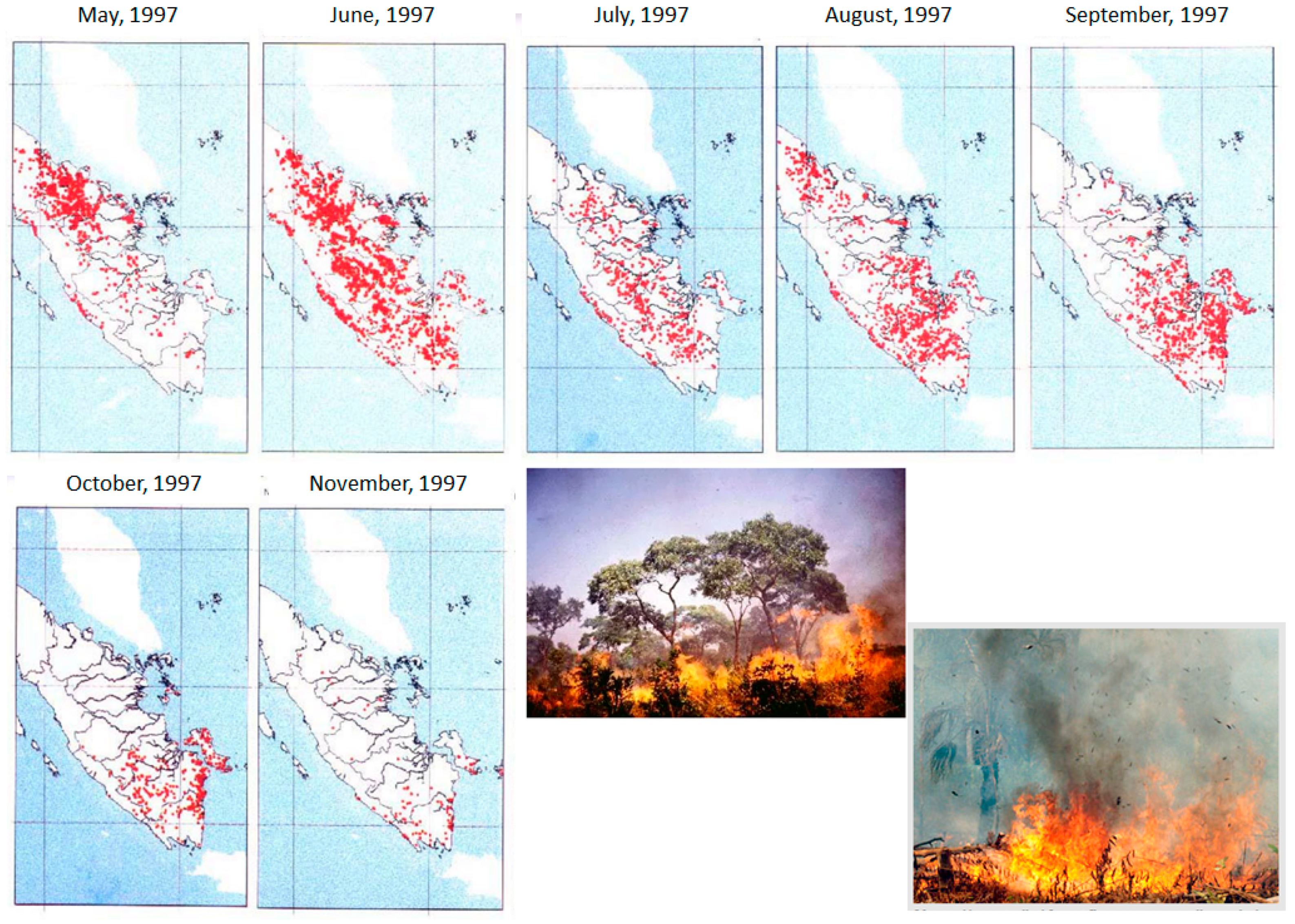

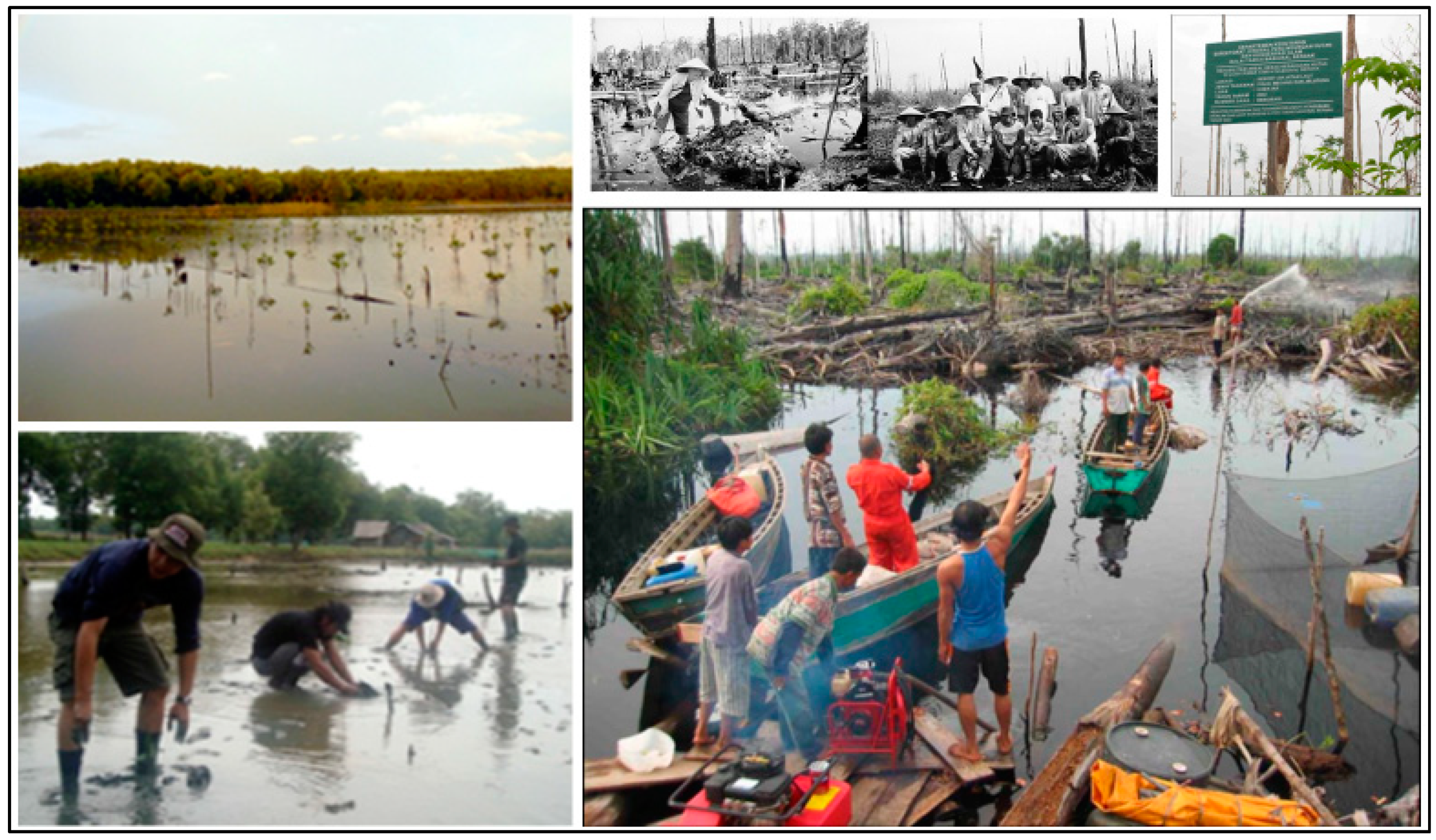

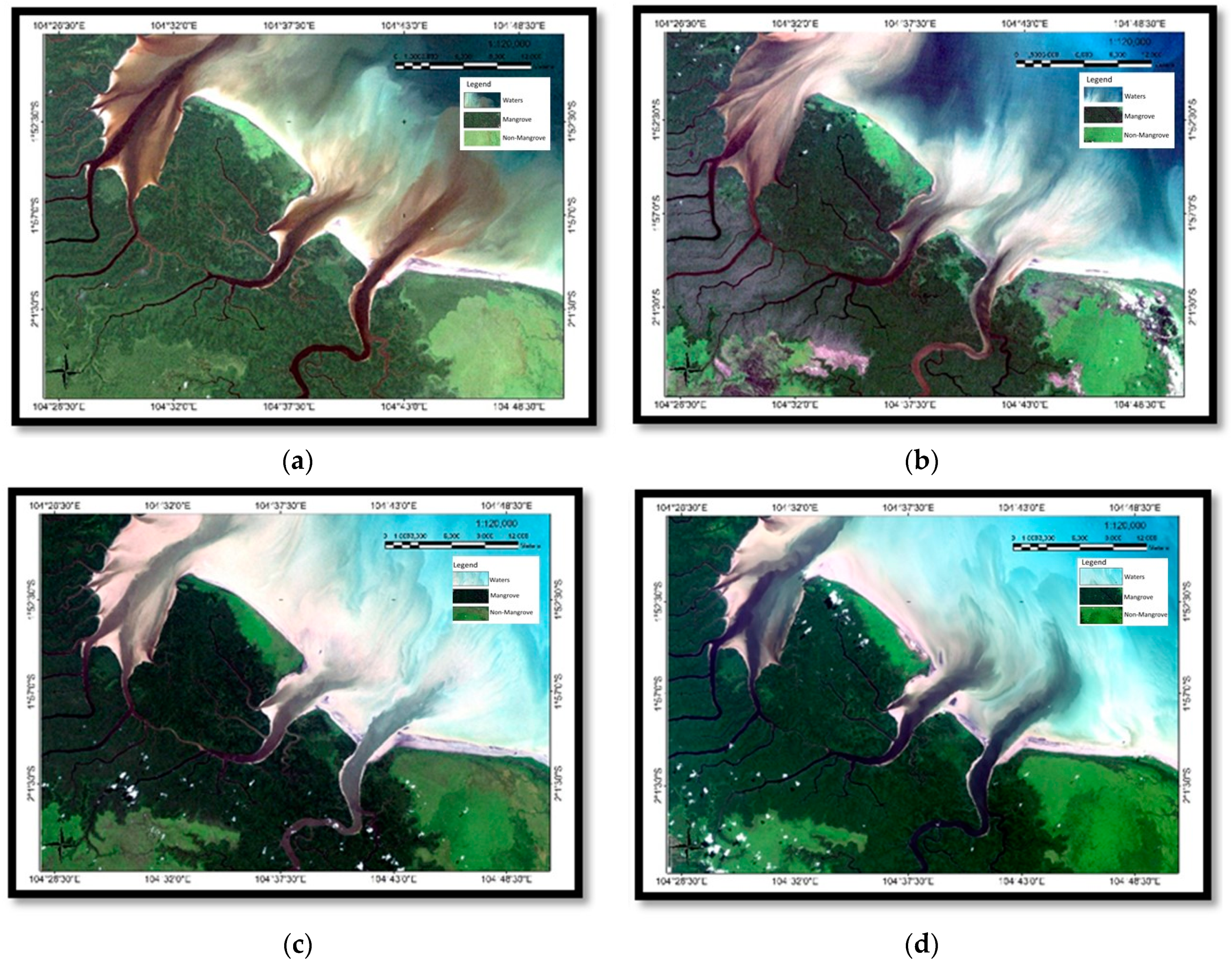
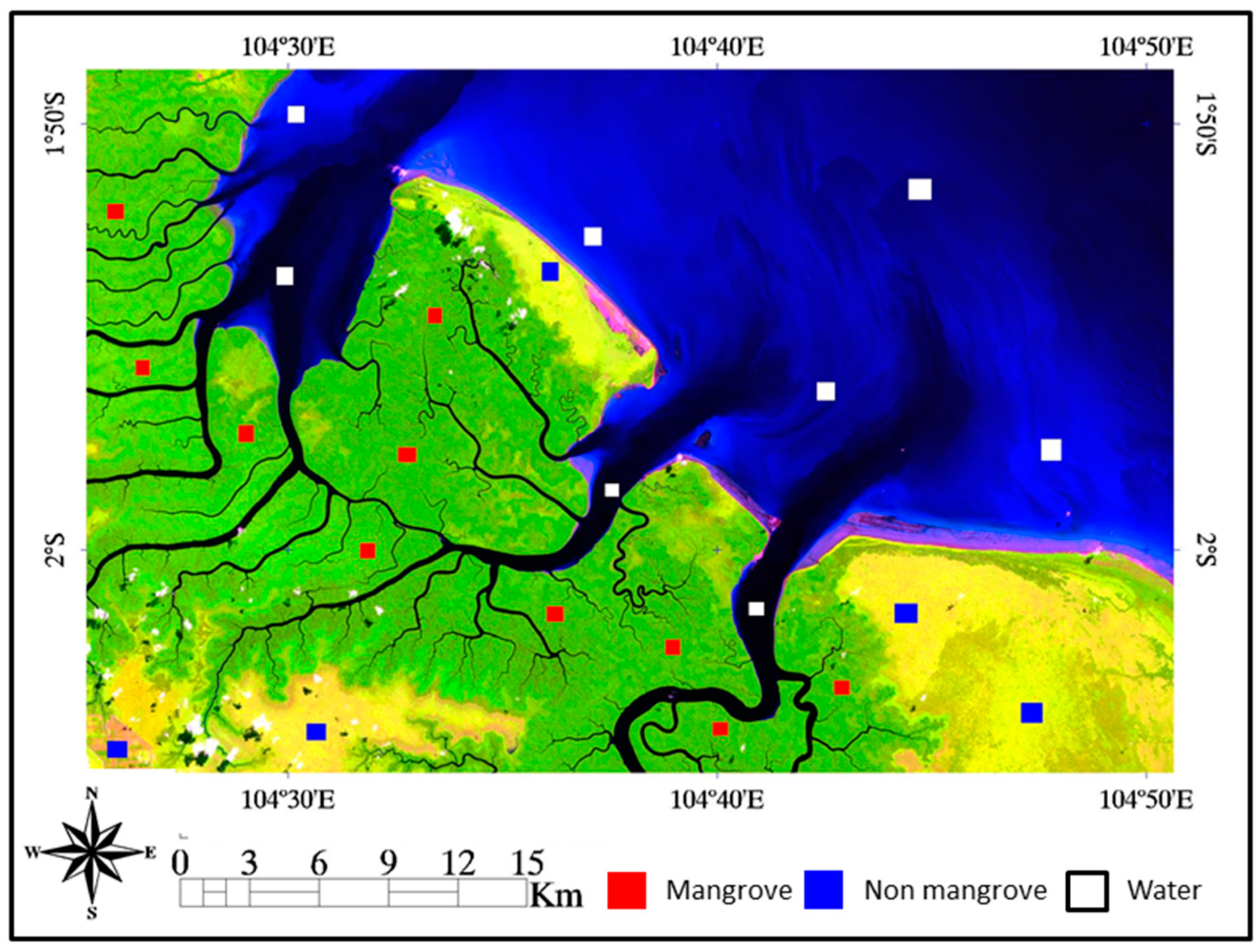
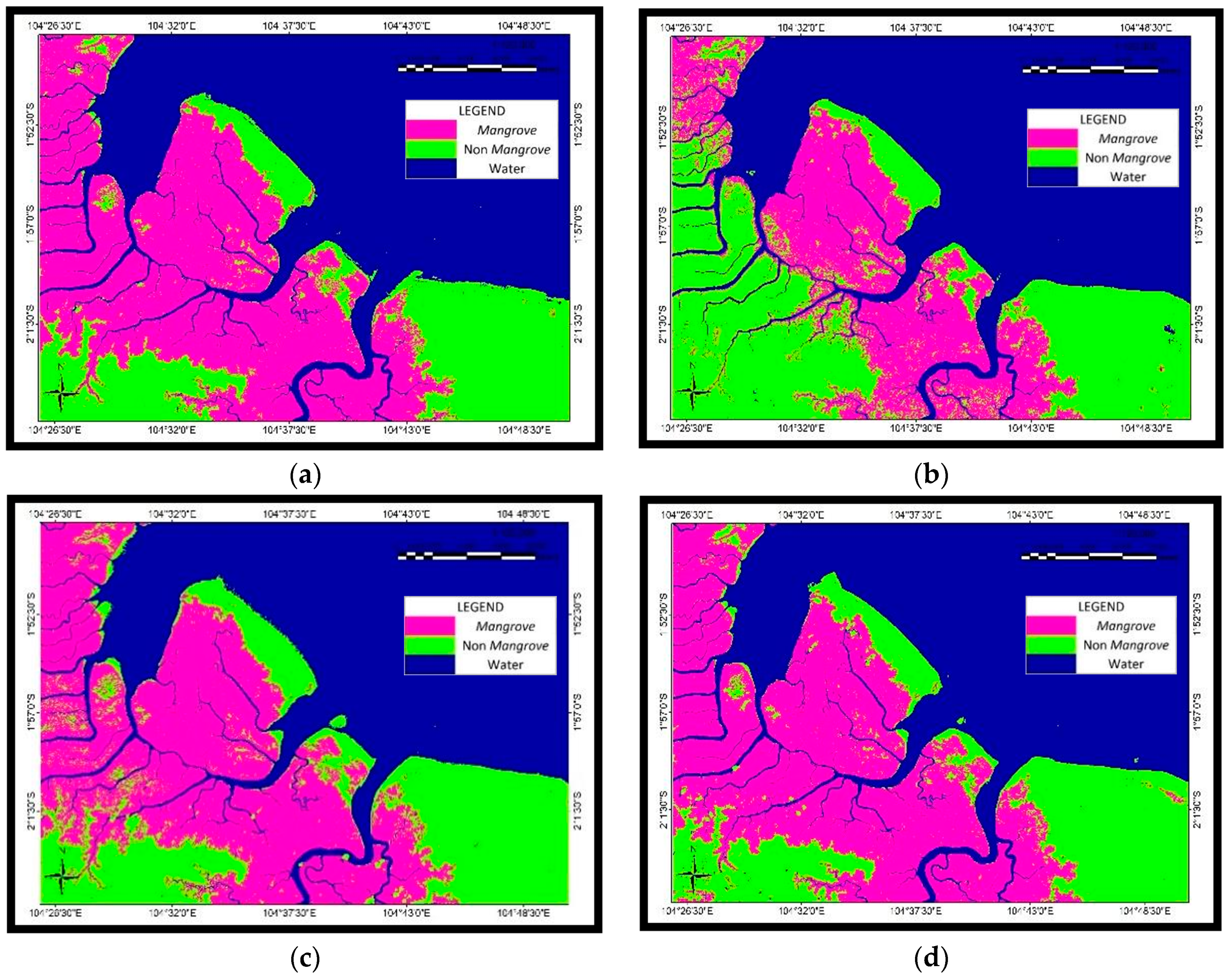
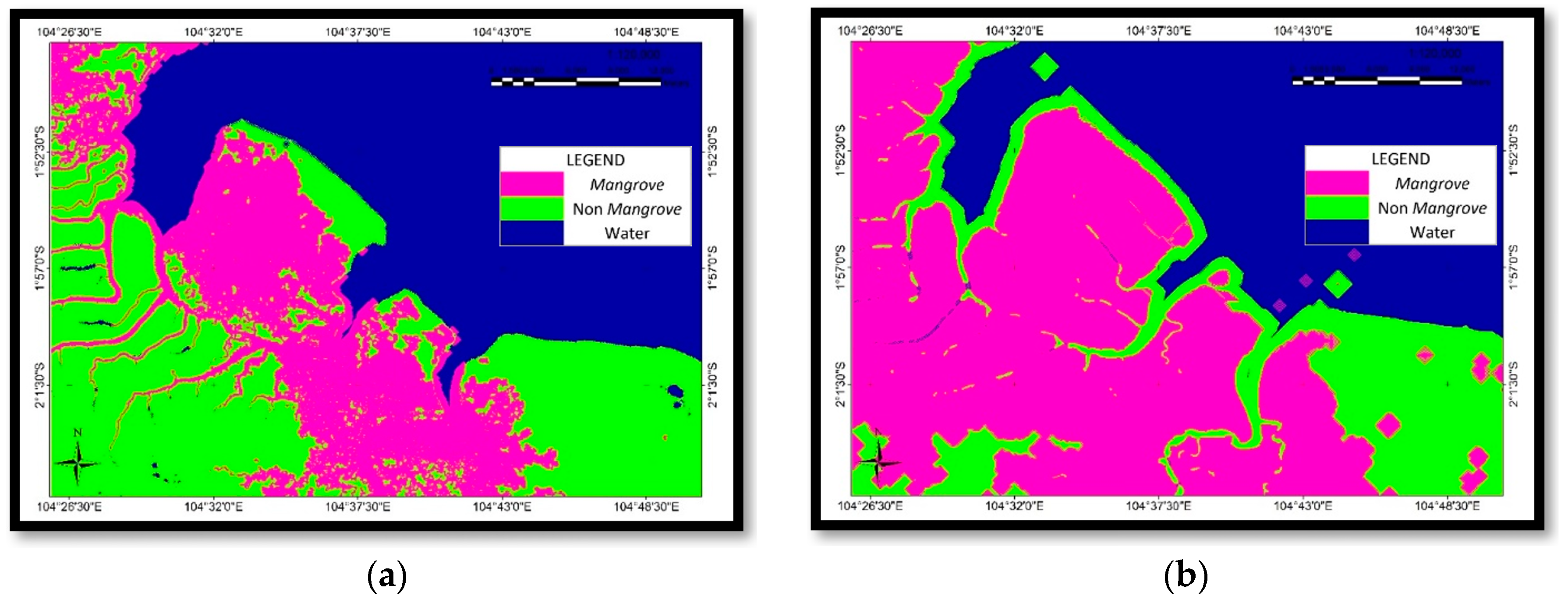
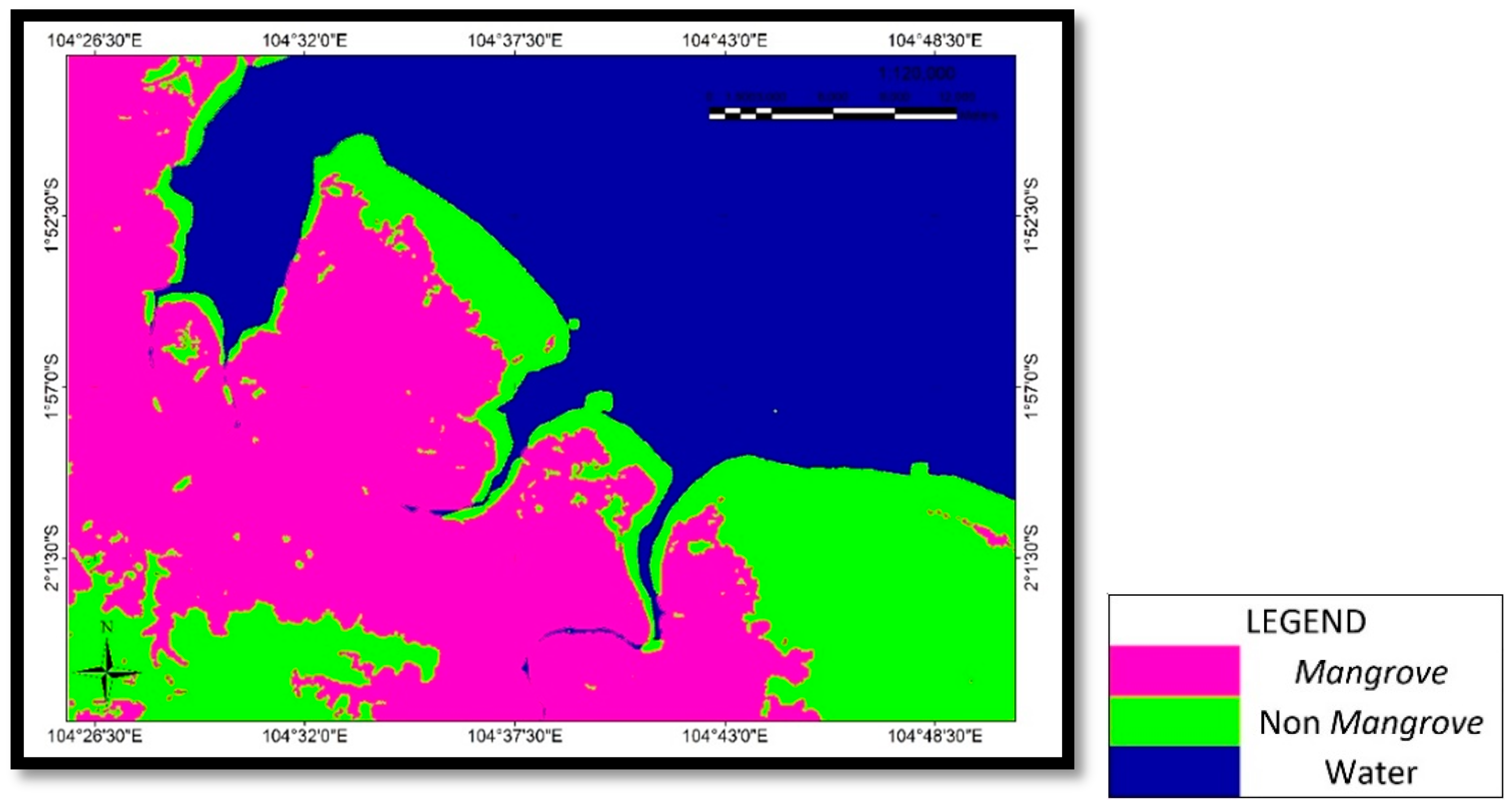

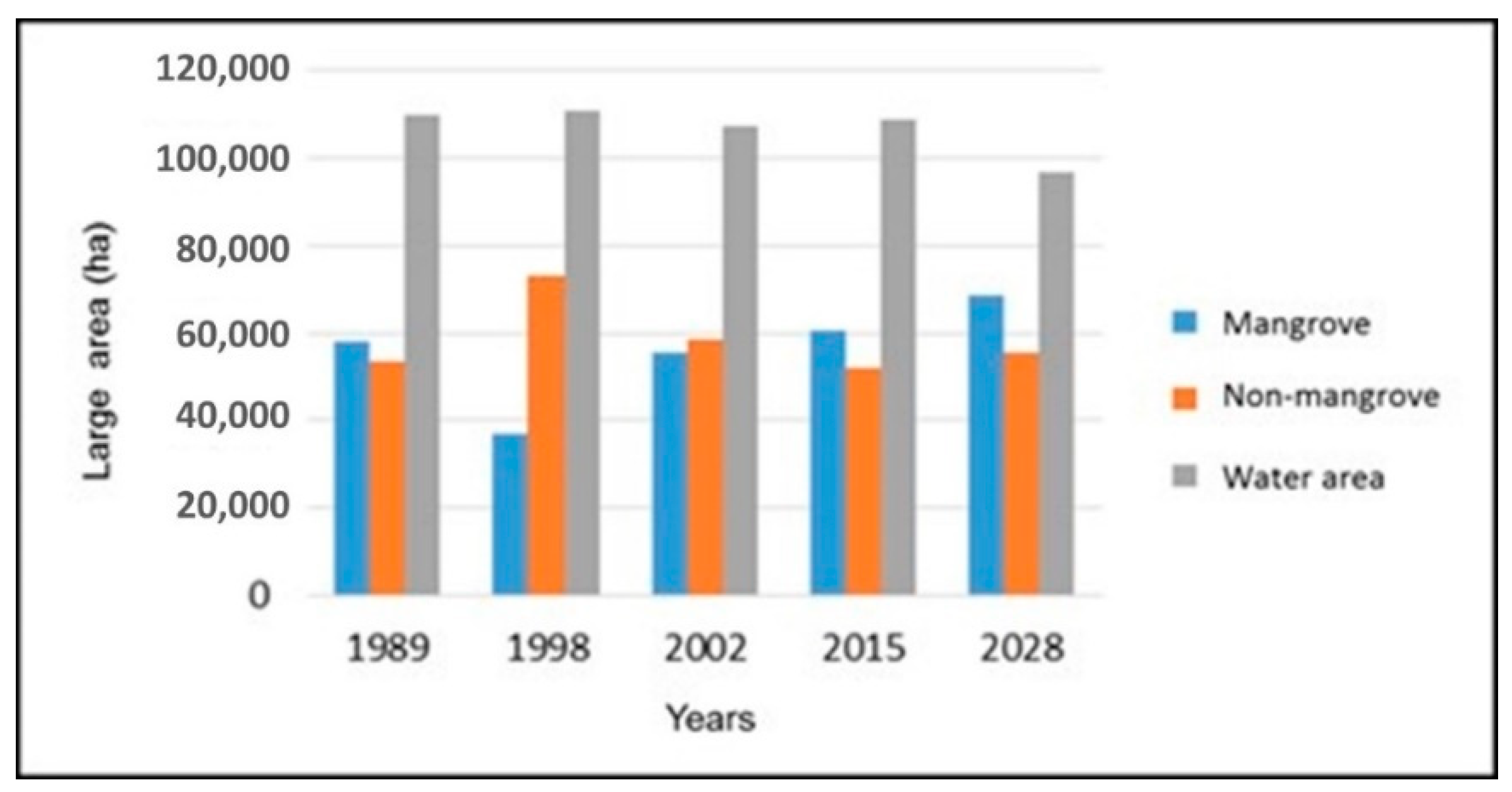
| Dataset | Date and Scale | Source |
|---|---|---|
| Landsat 5 | 17 May 1989 and 24 April 1998 | USGS |
| Landsat 7 ETM+ | 30 June 2002 | USGS |
| Landsat 8 OLI | 26 June 2015 | USGS |
| The administrative boundaries | 1:50,000 | BIG |
| Class | Definition |
|---|---|
| Non-mangrove | Land, built-up land, bare ground, roads, shrubs, vegetation, other habitats of mangrove. |
| Mangrove | A shrub or small tree that grows in coastal saline or brackish water. |
| Waters | Water in certain areas, both static and dynamic, such as seas, rivers, lakes. |
| Classification SVM | Classes | Training Data for Ground Check | |||||
| Mangrove | Non-Mangrove | Water | Total | User Accuracy | Error Commission | ||
| Mangrove | 495 | 2 | 0 | 497 | 99.6 | 0.4 | |
| Non-mangrove | 0 | 538 | 0 | 538 | 100 | 0 | |
| Water | 0 | 0 | 405 | 405 | 100 | 0 | |
| Total | 495 | 540 | 405 | 1440 | |||
| Producer Accuracy | 100 | 99.6 | 100 | OA | 99.8 | ||
| Error omission | 0 | 0.4 | 0 | Kappa | 0.9 | ||
| Classification SVM | Classes | Training Data for Ground Check | |||||
| Mangrove | Non-Mangrove | Water | Total | User Accuracy | Error Commission | ||
| Mangrove | 446 | 13 | 0 | 459 | 97.1 | 2.8 | |
| Non-mangrove | 4 | 649 | 0 | 653 | 97.4 | 0.6 | |
| Water | 0 | 4 | 342 | 346 | 100 | 1.1 | |
| Total | 450 | 666 | 342 | 1458 | |||
| Producer Accuracy | 99.1 | 97.4 | 100 | OA | 98.5 | ||
| Error omission | 0.9 | 2.5 | 0 | Kappa | 0.9 | ||
| Classification SVM | Classes | Training Data for Ground Check | |||||
| Mangrove | Non-Mangrove | Water | Total | User Accuracy | Error Commission | ||
| Mangrove | 533 | 17 | 1 | 551 | 96.7 | 3.2 | |
| Non-mangrove | 7 | 607 | 0 | 614 | 98.8 | 1.1 | |
| Water | 0 | 6 | 359 | 365 | 98.3 | 1.6 | |
| Total | 540 | 630 | 360 | 1530 | |||
| Producer Accuracy | 98.7 | 96.3 | 99.7 | OA | 97.9 | ||
| Error omission | 1.3 | 3.6 | 0.3 | Kappa | 0.9 | ||
| Classification SVM | Classes | Training Data for Ground Check | |||||
| Mangrove | Non-Mangrove | Water | Total | User Accuracy | Error Commission | ||
| Mangrove | 540 | 7 | 0 | 547 | 98.7 | 1.3 | |
| Non-mangrove | 0 | 623 | 0 | 623 | 100 | 0 | |
| Water | 0 | 0 | 360 | 360 | 100 | 0 | |
| Total | 540 | 630 | 360 | 1530 | |||
| Producer Accuracy | 100 | 98.1 | 100 | OA | 99.5 | ||
| Error omission | 0 | 1.1 | 0 | Kappa | 0.9 | ||
| Classes | Area (ha) and Percentages (%) | 1989 | 1998 | 2002 | 2015 |
|---|---|---|---|---|---|
| Mangrove | area (ha) | 58,145.5 | 36,847.4 | 55,548.3 | 60,697.5 |
| (%) | 26.2 | 16.6 | 25.1 | 27.4 | |
| Non-mangrove | area (ha) | 53,265.4 | 73,327.4 | 58,419.1 | 51,965.8 |
| (%) | 24.1 | 33.1 | 26.3 | 23.4 | |
| Water | area (ha) | 109,886 | 111,122 | 107,329 | 108,633 |
| (%) | 49.6 | 50.2 | 48.5 | 49.1 |
| Period | Land Cover | Mangrove | Non-Mangrove | Waters |
|---|---|---|---|---|
| 1989–1998 | Mangrove | 0.6 | 0.3 | 0 |
| Non-mangrove | 0.1 | 0.8 | 0.1 | |
| Water | 0.1 | 0.1 | 0.8 | |
| 1998–2002 | Mangrove | 0.7 | 0.2 | 0.1 |
| Non-mangrove | 0.7 | 0.3 | 0.1 | |
| Water | 0.1 | 0.2 | 0.7 | |
| 2002–2015 | Mangrove | 0.8 | 0.1 | 0.1 |
| Non-mangrove | 0.2 | 0.7 | 0.1 | |
| Water | 0.1 | 0.1 | 0.8 |
| Period | Land Cover | Mangrove | Non-mangrove | Waters |
|---|---|---|---|---|
| 1989–1998 | Mangrove | 266,660 | 142,756 | 0 |
| Non-mangrove | 84,159 | 668,662 | 61,928 | |
| Water | 141,087 | 46,333 | 1,047,267 | |
| 1998–2002 | Mangrove | 446,200 | 123,355 | 47,648 |
| Non-mangrove | 431,900 | 202,641 | 14,561 | |
| Water | 100,020 | 208,094 | 884,435 | |
| 2002–2015 | Mangrove | 547,050 | 99,300 | 28,066 |
| Non-mangrove | 128,752 | 414,686 | 33,960 | |
| Water | 87,208 | 104,804 | 1,015,025 |
| Classes | Area (ha) and Percentages (%) | Prediction (2002) | Prediction (2015) |
|---|---|---|---|
| Mangrove | area (ha) | 42,224.1 | 86,245.2 |
| (%) | 19.1 | 38.9 | |
| Non-mangrove | area (ha) | 77,012.6 | 47,087.1 |
| (%) | 34 | 21.2 | |
| Water | area (ha) | 10,059.9 | 87,964.2 |
| (%) | 46.1 | 39.7 |
| Kappa Index of Agreement | 2002 (Prediction) | 2015 (Prediction) |
|---|---|---|
| Kno | 0.7 | 0.7 |
| Klocation | 0.8 | 0.8 |
| KlocationStrata | 0.8 | 0.8 |
| Kstandard | 0.7 | 0.7 |
| Classes | Area (in ha) and Percentages (%) | 1989 | 1998 | 2002 | 2015 | 2028 |
|---|---|---|---|---|---|---|
| Mangrove | area (ha) | 58,145.5 | 36,847.4 | 55,548.3 | 60,697.5 | 68,672.3 |
| (%) | 26.2 | 16.6 | 25.1 | 27.4 | 31 | |
| Non-mangrove | area (ha) | 53,265.4 | 73,327.4 | 58,419.1 | 51,965.8 | 55,691.1 |
| (%) | 24.1 | 33.1 | 26.3 | 23.4 | 25.1 | |
| Water | area (ha) | 109,886 | 111,122 | 107,329 | 108,633 | 96,933.3 |
| (%) | 49.6 | 50.2 | 48.5 | 49.1 | 43.8 |
| Landsat Imagery | Tidal Height |
|---|---|
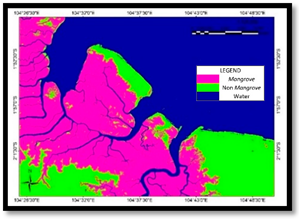 | 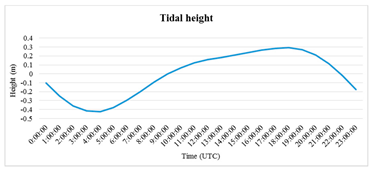 |
| 17 May 1989 | 17 May 1989 |
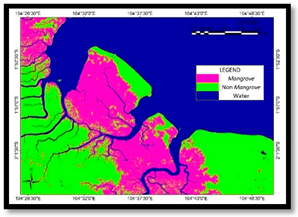 | 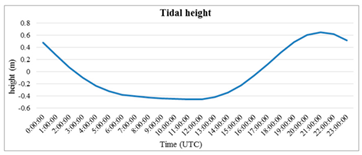 |
| 24 April 1998 | 24 April 1998 |
 |  |
| 30 June 2002 | 30 June 2002 |
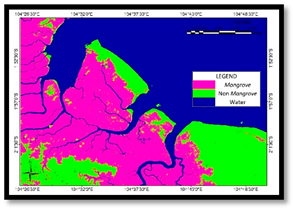 |  |
| 26 June 2015 | 26 June 2015 |
| Years | Overall Accuracy | Kappa Statistics | Mangrove User Accuracy | Mangrove Producer Accuracy |
|---|---|---|---|---|
| 1989 | 99.8 | 0.9 | 99.6 | 100 |
| 1998 | 98.5 | 0.9 | 97.2 | 99.1 |
| 2002 | 97.9 | 0.9 | 96.7 | 98.7 |
| 2015 | 99.5 | 0.9 | 98.7 | 100 |
Publisher’s Note: MDPI stays neutral with regard to jurisdictional claims in published maps and institutional affiliations. |
© 2020 by the authors. Licensee MDPI, Basel, Switzerland. This article is an open access article distributed under the terms and conditions of the Creative Commons Attribution (CC BY) license (http://creativecommons.org/licenses/by/4.0/).
Share and Cite
Darmawan, S.; Sari, D.K.; Wikantika, K.; Tridawati, A.; Hernawati, R.; Sedu, M.K. Identification before-after Forest Fire and Prediction of Mangrove Forest Based on Markov-Cellular Automata in Part of Sembilang National Park, Banyuasin, South Sumatra, Indonesia. Remote Sens. 2020, 12, 3700. https://doi.org/10.3390/rs12223700
Darmawan S, Sari DK, Wikantika K, Tridawati A, Hernawati R, Sedu MK. Identification before-after Forest Fire and Prediction of Mangrove Forest Based on Markov-Cellular Automata in Part of Sembilang National Park, Banyuasin, South Sumatra, Indonesia. Remote Sensing. 2020; 12(22):3700. https://doi.org/10.3390/rs12223700
Chicago/Turabian StyleDarmawan, Soni, Dewi Kania Sari, Ketut Wikantika, Anggun Tridawati, Rika Hernawati, and Maria Kurniawati Sedu. 2020. "Identification before-after Forest Fire and Prediction of Mangrove Forest Based on Markov-Cellular Automata in Part of Sembilang National Park, Banyuasin, South Sumatra, Indonesia" Remote Sensing 12, no. 22: 3700. https://doi.org/10.3390/rs12223700
APA StyleDarmawan, S., Sari, D. K., Wikantika, K., Tridawati, A., Hernawati, R., & Sedu, M. K. (2020). Identification before-after Forest Fire and Prediction of Mangrove Forest Based on Markov-Cellular Automata in Part of Sembilang National Park, Banyuasin, South Sumatra, Indonesia. Remote Sensing, 12(22), 3700. https://doi.org/10.3390/rs12223700









